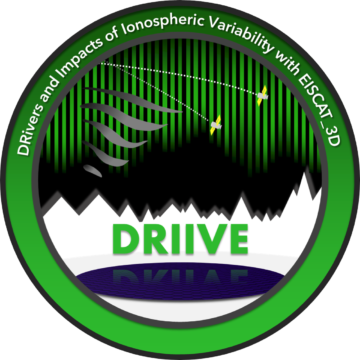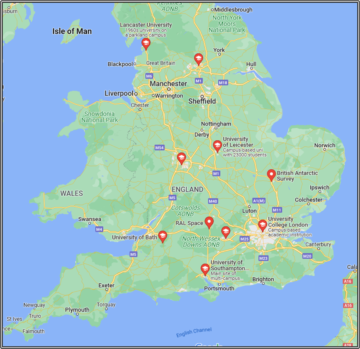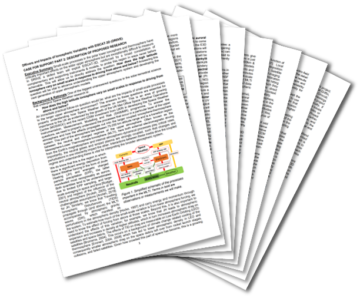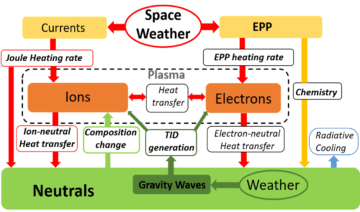DRIIVE
DRivers and Impacts of Ionospheric Variability with EISCAT-3D (DRIIVE)
- Start date
- 10 April, 2022
- End date
- 9 April, 2026
 DRIIVE will use the new EISCAT_3D radar to understand multi-scale coupling in the Ionopshere and how it is influenced both by space weather and the lower atmosphere. The impact of small-scale changes of the upper atmosphere on the orbits of satellites will be assessed and used to improve the existing models for better predictions of orbital evolution for satellites and space debris.
DRIIVE will use the new EISCAT_3D radar to understand multi-scale coupling in the Ionopshere and how it is influenced both by space weather and the lower atmosphere. The impact of small-scale changes of the upper atmosphere on the orbits of satellites will be assessed and used to improve the existing models for better predictions of orbital evolution for satellites and space debris.
High above our head lies the Ionosphere – a region at the edge of space where the molecules of our atmosphere are partially ionized – split into electrons and ions. Here, electrical currents flow, linking our atmosphere to processes occurring further out in space in our geomagnetic environment. Many of these processes are driven by interactions with the Sun via the solar wind and are what we often call Space Weather.
Space Weather can have serious impacts on our modern technology, and although the ionosphere is not very dense, it can affect the orbits of satellites, the passage of radio waves and influence the security of our power networks. Although these impacts are generally well known, there are still many unanswered questions about how the ionosphere responds to space weather and its interaction with the rest of the atmosphere.
One reason why we have not yet fully understood this region is that it is hard to make measurements there, and particularly difficult to look at how changes occur at small scales. Lots of models of the region rely on averages over 10s -100s km or several degrees of longitude and latitude. Yet there is strong evidence that effects at small scales (few to 10s km) can be really important.
This project makes use of the new, state of the art EISCAT_3D radar to probe the upper atmosphere at small scales to properly understand how space weather and the motion and composition of the atmosphere affects the ionosphere and the orbits of satellites that pass through it.

DRIIVE is a 4 year NERC funded Highlight Topic bringing together 19 scientists from 10 UK institutes, with 14 international project partners from 8 countries.
 The principle aim of DRIIVE is to exploit the new EISCAT_3D radar to explore the ionosphere at multiple scales. We will increase our understanding of the ionosphere’s fundamental underpinning science by exploiting EISCAT_3D’s new capabilities and to by explore the hidden 3D ionosphere in order to predict its impacts on the global earth system
The principle aim of DRIIVE is to exploit the new EISCAT_3D radar to explore the ionosphere at multiple scales. We will increase our understanding of the ionosphere’s fundamental underpinning science by exploiting EISCAT_3D’s new capabilities and to by explore the hidden 3D ionosphere in order to predict its impacts on the global earth system
The work in this project is spread across several related themes, all focused on interactions at spatial scales below ~100 km in the high latitude, coupled Mesosphere-Thermosphere-Ionosphere.
There are four key objectives that form the principle work packages of DRIIVE:
- determine the impact on the high latitude ionosphere of lower atmosphere forcing via small scale waves
- establish how changes in the local composition affect ionospheric variability, and what drives this
- quantify the energy deposition from energetic charged particle precipitation and Joule heating at small scales, and how this impacts variability
- estimate the effect of small-scale changes to atmospheric heating on the space debris environment, through changes in atmospheric drag.
BAS scientists are involved in several of these work packages and lead two of them:
In Work Package 1 we will:
- determine the sources of ionospheric waves, whether in-situ or traced from the lower atmosphere
- quantify the ionospheric impact of these waves on instabilities
- estimate the underlying ionospheric variability driven by these wave
In Work Package 3 we will:
- identify the small-scale spatial distribution of the energy-flux of precipitation and Joule heating
- assess how EISCAT-derived ionisation rates compare with established particle inputs to whole atmosphere models
- estimate the relative balance of the forcing of the MLTI region between the lower atmosphere and space weather.

Andrew Kavanagh
Middle Atmosphere Vertical Coupling Analyst
BAS Science Management Team, BAS-Arctic Working Group, Space Weather and Atmosphere team